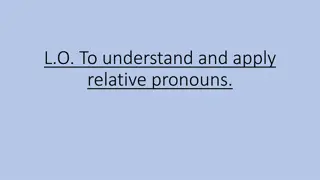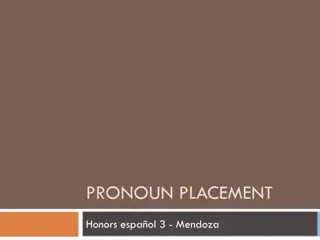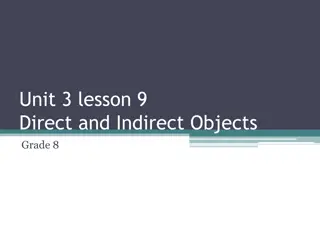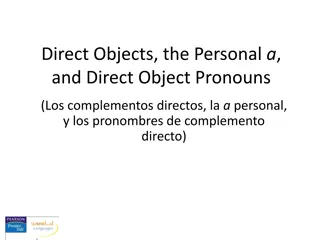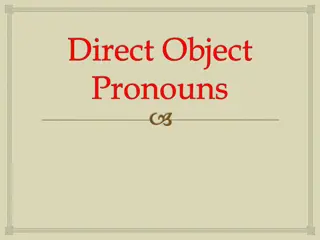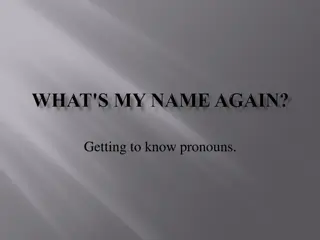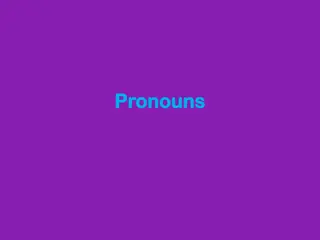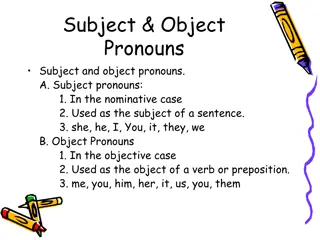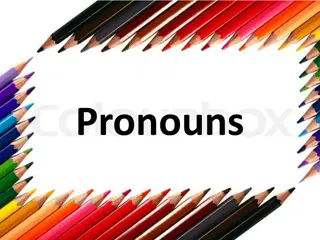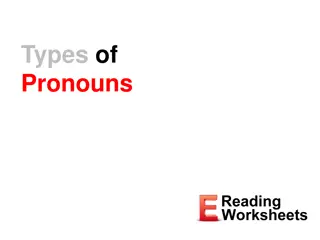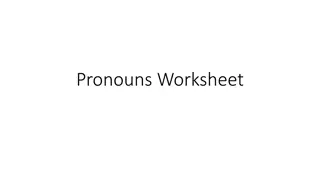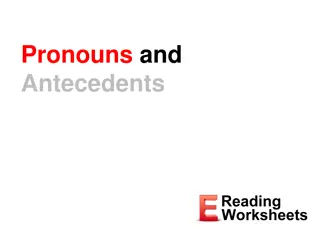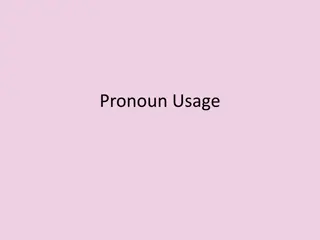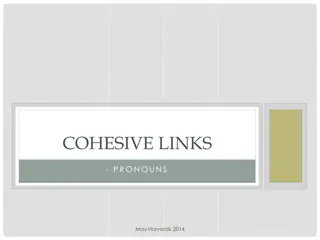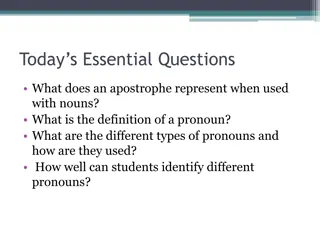Understanding Direct Objects and Direct Object Pronouns in English and French
Explore the concepts of direct objects and direct object pronouns in English and French languages. Learn how direct objects are used in sentences, the role of direct object pronouns in avoiding repetition, and the differences in sentence structure when using object pronouns in French. Discover common direct object pronouns in both languages and their placement in sentences for effective communication.
Download Presentation

Please find below an Image/Link to download the presentation.
The content on the website is provided AS IS for your information and personal use only. It may not be sold, licensed, or shared on other websites without obtaining consent from the author. Download presentation by click this link. If you encounter any issues during the download, it is possible that the publisher has removed the file from their server.
E N D
Presentation Transcript
DIRECT OBJECTS AND DIRECT OBJECT PRONOUNS In French and English BY MAC
WHAT IS A DIRECT OBJECT? Look at the sentence: I eat the cookie. The subject is who or what is doing the action. (I) The verb is the action of the sentence. (eat) The direct object is what the verb is acting on. What do I eat? The direct object is the cookie!
DIRECT OBJECTS What is the direct object of the following sentence. I eat the cookie. What do I eat?
LETS TRY AGAIN Joe throws the ball. What does Joe throw? The direct object is . The ball!
DEFINITION Direct object pronouns are used to avoid repeating direct object nouns that have already been mentioned
SUBSTITUTION Sometimes I want to avoid repeat the object and I will replace the direct object with a direct object pronoun in English. I eat the cookie. I eat it. Joe threw the ball. What could we use to replace ball? Joe threw it!
DIRECT OBJECT PRONOUNS The direct object pronouns in English are; Me, you, him, her, it, us, and them. Notice that these pronouns are not the same as subject pronouns. They are placed in a different part of the sentence and they can t be used as a subject. We never say; Them threw the ball. So guess what? THE SAME THING HAPPENS IN FRENCH.
D.O.P.S IN FRENCH Me (Me) Nous (Us) Te/T (You) Vous (You) Le/La (Him/Her) Les (Them)
SENTENCE STRUCTURE Normally in English and in French, we have the order of a sentence which is called SVO = Subject Verb Object. Look at these sentences. I eat the cookie (SVO) I eat it. (SVO) Je mange le biscuit. (SVO) but Je le mange. (SOV) When we have object pronouns in French the structure of the sentence changes. It is basically saying I it eat. Kind of like when we have adjectives after the noun in French, the is sometimes a different sentence structure or word order in French. Don t let that confuse you, just follow the steps for placement.
PLACEMENT - The direct object goes before the conjugated or in front of the infinitive. - If there is an infinitive the DOP must go in front of it! - DOP = Direct Object Pronoun
WHAT ABOUT FRENCH? Some direct objects we have already seen in French. How do you say My name is Je m appelle Madame Mac. It means I call myself Here are some more examples
ME/ M Elle m aime She loves me (it is before the vowel so it turns into m )
TE/ T Je t aime I love you
LE/LA Je le mange I eat it
NOUS Elle nous aime She loves us
VOUS Je vous aime I love you all
LES Il les trouve He finds them
NOW YOU TRY ONE IN FRENCH Je mange le biscuit. Biscuit is the direct object noun. It can be replaced by le.
WHAT IS THE RESULTING SENTENCE? DOPs must go IN FRONT of the conjugated verb or IN FRONT of the infinitive if there is one. Je le mange.
BUT WAIT I HAVE AN INFINITIVE? Infinitives in French are any word that ends in ER, IR or RE. Think faire, penser, dormir, even irregular verbs like avoir still end in IR, ER or RE. In English, Infinitives are TO + a Verb, to do, to think, to sleep, etc. When we have a direct object in English the placement stays the same. I am going to eat the cookie. I am going to eat it. In French, it is a little bit different, the object pronouns must be placed BEFORE the infinitve. Take a look at the same sentence in French. Je vais manger le biscuit. Je vais le manger.
STEPS TO REPLACING A DIRECT OBJECT. Step One: Locate the Direct object noun in the sentence. It is usually a noun after the verb and should answer the question What did the verb do? Step Two: Determine which one of the DOPs in French would replace the direct object. Step Three: Is the an infinitive in the sentence? If yes, the DOP is placed before it. Step Four: If there is no infinitive, then find the verb. The DOP will go before it. Step Five: Rewrite your sentence with the DOP in the proper place. Remember, the Direct Object Noun will no longer be there. Example: Je fais les devoirs. I do the homework. The DO is les devoirs It can be replaced by les. There is no infinitive in the sentence, the verb is fais. Les will be placed before fais. Je les fais is the resulting sentence! I do them (it) Homework is plural in French.
INDIRECT OBJECTS Indirect objects are nouns that receive the benefit of the noun. I gave the notebook to Nico. The direct object is what I gave = the notebook. The indirect object is who is benefiting (receiving) the notebook. (Nico) In French, the same thing happens. Je donne le cahier Nico. (Nico is the indirect object)
INDIRECT OBJECT PRONOUNS ME (TO ME) NOUS (TO US) TE (TO YOU) VOUS (TO Y ALL) LUI (TO HIM OR TO HER) LEUR (TO THEM)
PLACEMENT DIRECT OBJECTS (DOPS) AND INDIRECT OBJECT PRONOUNS ARE PLACED BEFORE THE CONJUGATED VERB OR IN FRONT OF THE INFINITIVE IF THERE IS ONE. IF YOU HAVE MULTIPLE PRONOUNS IN ONE SENTENCE, FOLLOW THIS ORDER; ME LA LUI Y EN TE L LEUR NOUS LE VOUS Les



